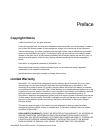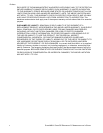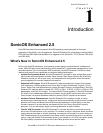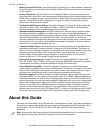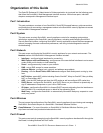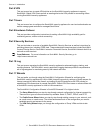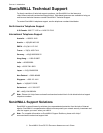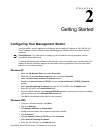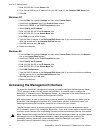SONICWALL SONICOS 2.5 ENHANCED ADMINISTRATOR’S GUIDE
3
About this Guide
Organization of this Guide
The SonicOS Enhanced 2.5 Administrator’s Guide organization is structured into the following parts
that follow the SonicWALL Web Management Interface structure. Within these parts, individual
chapters correspond to Management Interface layout.
Part 1 Introduction
This part provides an overview of new SonicWALL SonicOS Enhanced features, guide conventions,
and instructions for connecting a management station to the SonicWALL security appliance to access
the SonicWALL Management Interface.
Part 2 System
This part covers a variety SonicWALL security appliance controls for managing system status
information, registering the SonicWALL security appliance, activating and managing SonicWALL
Security Services licenses, configuring SonicWALL security appliance local and remote management
options, managing firmware versions and preferences, and using included diagnostics tools for
troubleshooting.
Part 3 Network
This part covers configuring the SonicWALL security appliance for your network environment. The
Network section of the SonicWALL Management Interface includes:
• Interfaces - configure logical interfaces for connectivity.
• WAN Failover and Load Balancing - configure one of the user-defined interfaces to act as a sec-
ondary WAN port for backup or load balancing.
• Zones - configure security zones on your network.
• DNS - set up DNS servers for name resolution.
• Address Objects - configure host, network, and address range objects.
• Routing - view the Route Table, ARP Cache and configure static and dynamic routing by inter-
face.
• NAT Policies - create NAT policies including One-to-One NAT, Many-to-One NAT, Many-to-Many
NAT, or One-to-Many NAT.
• ARP - view the ARP settings and clear the ARP cache as well as configure ARP cache time.
• DHCP Server - configure the SonicWALL as a DHCP Server on your network to dynamically as-
sign IP addresses to computers on your LAN or DMZ zones.
• IP Helper - configure the SonicWALL to forward DHCP requests originating from the interfaces on
the SonicWALL to a centralized server on behalf of the requesting client.
• Web Proxy - configure the SonicWALL to automatically forward all Web proxy requests to a net-
work proxy server.
Part 4 Wireless
The part covers the configuration of the SonicWALL security appliance for provisioning and managing
SonicWALL SonicPoints as part of a SonicWALL Distributed Wireless Solution.
Â
Cross Reference: For more information on SonicWALL’s Distributed Wireless Solution, go to
http://www.sonicwall.com/products/wirelesssolutions.html.
Part 5 Firewall
This part covers tools for managing how the SonicWALL security appliance handles traffic through the
the firewall, including Multicast and VoIP traffic.



